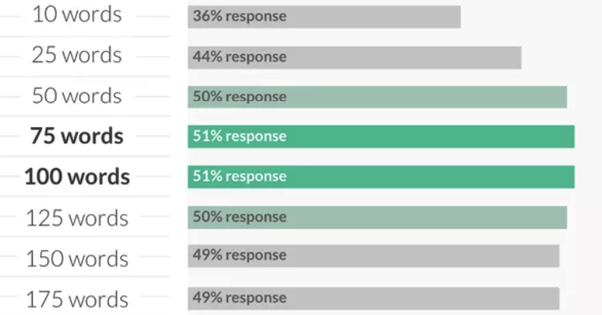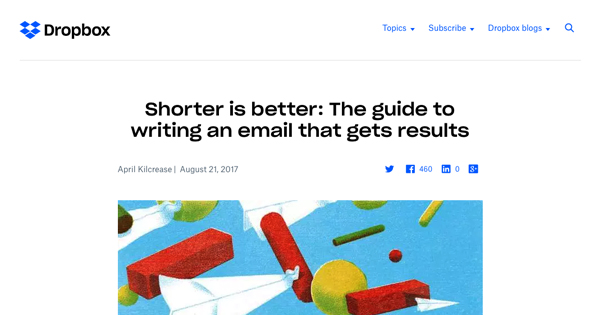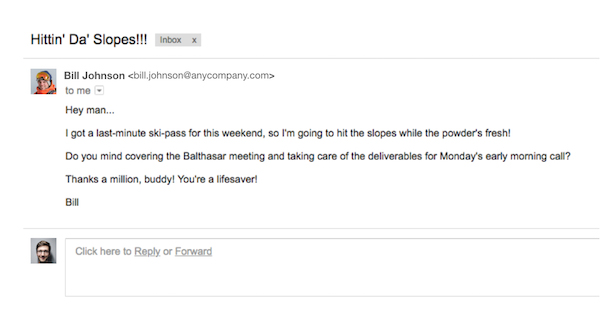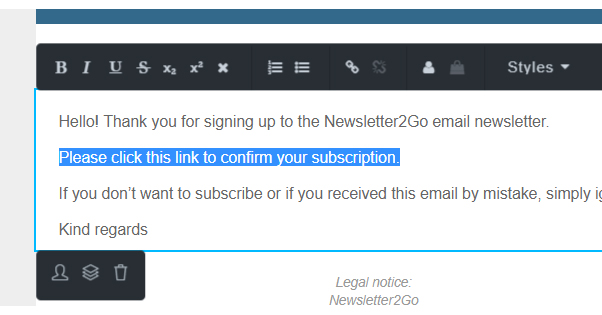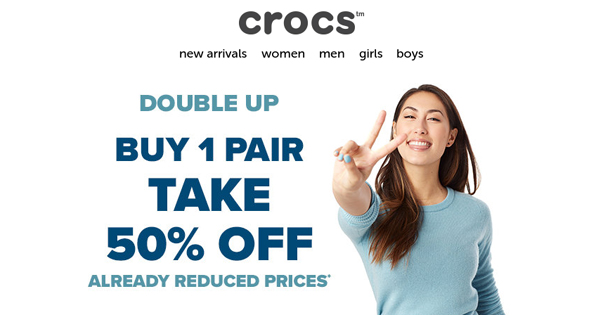Short vs Long Emails: Why Shorter Is Usually Better
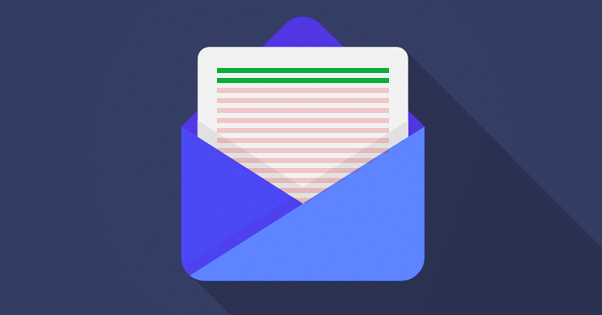
If you look around the internet for advice about writing emails, you’ll find one refrain that rises above all the rest: shorter is better. Shorter emails convert better, they have a larger open rate and response rate, and they solve world hunger every time they’re sent.
Okay, so that last one isn’t true. Still, though, shorter emails are unquestionably the way to go. But why?
Packing a Punch
Shorter emails are generally better because they can pack more punch into a smaller amount of space.
One thing you might have noticed about blog writing is that people tend to be fairly verbose. The pressures of SEO lead to larger blog posts where there’s more opportunity to show authority, present data, and include keywords. My own blog posts tend to range around 2,000 words in length, plus or minus a hundred or so. I’ve found this to be an effective middle ground between overly long posts and too-short-to-matter posts.
With emails, you don’t have the pressure of SEO. It doesn’t matter how keyword optimized the message is for search; it’s delivered right to the inbox of the people most interested in the message already.
Remember, too, that the purpose of a blog post is to bring in new people, inform them, position yourself as a thought leader, and attract those users into your sales funnel. Meanwhile, the purpose of an email is to further lead people already in your funnel to another place deeper down; a landing page, a conversion page, or what have you.
A short email is able to create a curiosity gap as well. How many marketing emails or drip campaigns have you received that have fewer than 100 words in them? They ask you a question, provide you the start of an answer, and give you a link to further reading. That link leads to a landing page, a sign-up page for a course, or whatever the user is selling. You’re curious, so you click, and if your interest and their copy coincide, you convert.
The Time Investment
Short emails have one other great benefit, which is respect. They show respect for the time of the person you’re sending the message to. Sure, some people will be checking their inbox and see maybe a dozen emails each day, most of them easily discarded newsletters or offers they don’t care about. Other people have to dig through hundreds or even thousands of emails every day.
A shorter email is more likely to receive attention and a response than a longer email. The people reading have so much to dig through that, if you don’t capture their attention and gain their trust in a few sentences, they’re likely to discard the message rather than read through the whole thing. It’s the same way with blog posts; if you don’t capture attention in the first few paragraphs, and sometimes even just the title, the users bounce off.
The difference here is, again, the targeting. An email is going to someone who expects it and has at least a basic interest in it, either because they bought a product or they signed up for a list. A blog post is a filter to gather those initially interested users.
Though many people won’t be able to expressly put the thought into words, they’ll be more likely to engage with a shorter email because it shows you have a respect for their time.
Purpose of the Message
Now, I keep talking about how shorter emails are generally better, but that’s only true in certain contexts. Much like everything in life, there are details and exceptions to every rule. In general, shorter is better, but there are good reasons where a longer message might work best.
The purpose of the message is incredibly important in determining how long the message should be. Let’s discuss a few different types of emails.
Personal messages. Personal messages can be whatever you need them to be. Maybe you’re sending a message to grandma and want to update her on the last six months of your life; sure, write as much as you need. Maybe you’re just trying to gather the family for the annual holiday get-together, in which case you want to keep is as simple as possible and just shoot out information on the date, time, and venue.
Honestly, you can disregard most email rules when it comes to personal messages. There’s no reason to be concerned about open rates or conversion rates when you’re just chatting with your family or friends. Unless, of course, you’re trying to shill MLM to them, in which case you don’t have to care because your MLM is providing their Proven To Work Email Templates or whatever emoji-filled BS they want you to use.
Internal to-coworker messages. Much like personal messages, internal company messages don’t need to follow email rules, though your coworkers will likely appreciate shorter messages.
The most important thing with internal messages is to know who you’re talking to and what their skill level and reading comprehension is. I’ve seen all too many instances where you send a message with a question like “Hey, should we do A or B?” only to receive the simple answer “yes.”
Remember that you’re busy, and so are your coworkers. Many of them are going to look for the first question or pertinent bit of information and answer that, shoot off a reply, and think they’re good. “Should we do A or B” becomes “should we do A y/n?” They answer what they think the question is, and you’re left with an unhelpful communication and a waste of time.
Remember, too, that shorter messages take less time to write. Honestly, with business communications, I’ve often found that shorter emails are better just because they let you ask a single question, get a single answer, and get on with life. If you have multiple questions you need answered, it’s generally better to hop on the phone or meet with the coworker in person. A discussion can solve the questions and the secondary concerns much more quickly.
Business to customer messages. There are three styles of business-to-customer messages. One of them is the simple announcement, which is what this category represents. The other two are standard newsletters and drip campaigns, which I’ll cover next.
Simple announcements are better short. A service outage or an update about an outage, the announcement of a new product, a webinar sign-up, or whatever; these are all best kept short because of all of the reasons I’ve listed above. They respect the time of the reader, they provide a curiosity gap that can lead to landing page hits, and so on.
The exception are more lengthy messages that might be required by law in some cases. For example, if your company experiences a data breach, you may be legally required to disclose the breach, along with all the information you have about when it happened, what might or might not be compromised, what actions you’re taking to secure user data, and so on. Though, I personally suspect some of the length of these messages is there to baffle customers and keep them from attempting to organize against the business.
Opt-in drip campaigns. When a user opts in, you might send a drip campaign. Such a campaign runs asynchronously. That is, each user experiences the same set of emails in the same order with the same delay between them, starting when they sign up, rather than on a global cycle.
Drip campaigns can be optimized to whatever needs you have. Depending on the source of the sign-up, they might be better short or better long. A user who signs up for your newsletter might be better off with a short series of emails convincing them to consider buying your product. A drip campaign for a user who buys your product might be better off longer as a sort of distributed tutorial.
Close.io, a sales-focused CRM, studied their own drip campaign. You can read about their conclusions here. One of the most interesting things is they show you their highest converting email in their drip campaign sequence. It’s a huge email with a number of different sections.
What’s truly interesting about this message is that it has a lot going on. It discloses up front that it’s a sales letter, it goes into the background of the product, it includes several different bulleted or numbered lists, and it even has testimonials from customers. It’s basically a landing page all together in an email.
The secret to this email is that it’s midway along a sustained drip campaign for interested users. The only people who even receive the email are those who are already at least partially interested in continuing. The audience for it has self-selected by this point; anyone not interested has already ceased opening the messages and may have unsubscribed to them. If that blog post sized message was the first one in a series, you’d bounce off immediately, no matter how much you like the product.
Newsletters. The final kind of business to customer message is the regularly scheduled newsletter. Here, both short and long emails will work, and it depends on the kind of relationship you’ve fostered with your readers, as well as the purpose of the message.
In general, for these, I think of it on a sliding scale. The more time there is between newsletters, the longer the newsletter can be. If you send out one message every month with a digest of your best blog posts that month and a sales call to action, it can be a longer message. If you’re sending out a daily newsletter, it should probably be pretty short.
In part, this is entirely self-serving. If you’re sending out daily messages, if nothing else, you’re going to struggle to come up with content. Can YOU think of 365 different things to say this year without driving away some readers? I know I can’t without some serious attention.
Making Long Emails Work
Long emails can be as effective as short emails. The key is to reduce the time it takes to read them as much as possible. Check out that Close.io message again. What do you see? A lot of sub-headings, a lot of short lists, a lot of key items in bold, and a lot of superfluous text left without any of that formatting. Despite being hundreds of words long, you can scan through it in a few seconds and get the gist of the whole thing.
Making a long-form email work means making it pretend to be a short email. Do everything you can to reduce the amount of time or attention it takes to read, and make sure to front-load any important value or calls to action.
I view it as making a short email with a longer expansion. If you cut off everything except the first paragraph or two, it should work on its own. The rest is icing on the cake; more detail and information for the people who want it, but nothing the casual reader can’t get elsewhere if they want.
Finally, of course, test your audience. It’s incredibly easy to segment your mailing list and send a short email to half of them and a longer email to the other half. Which side has better engagement rates? It’s one of the simplest split tests to perform in all of marketing.


